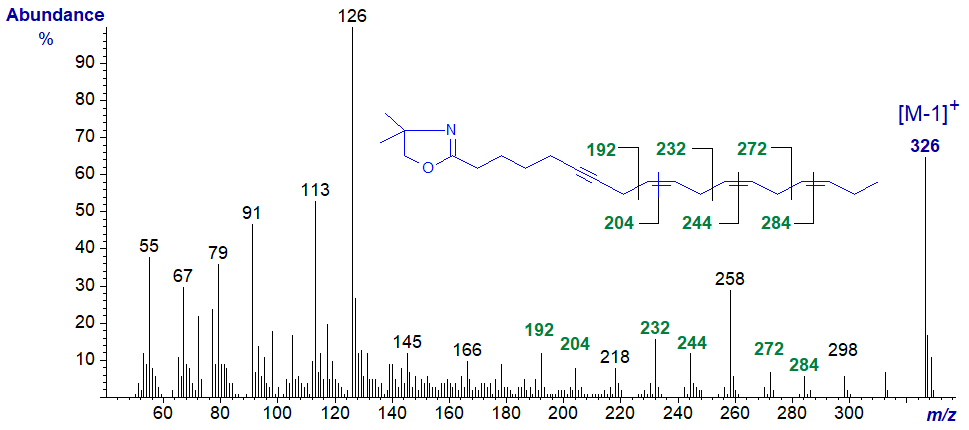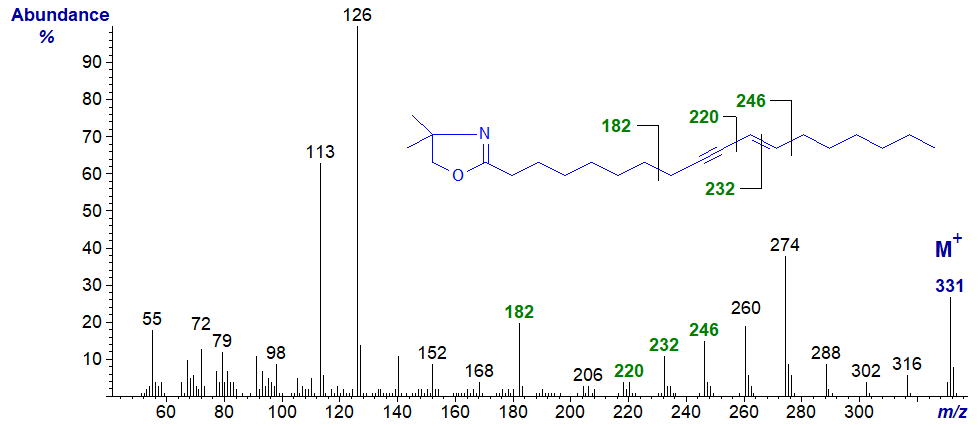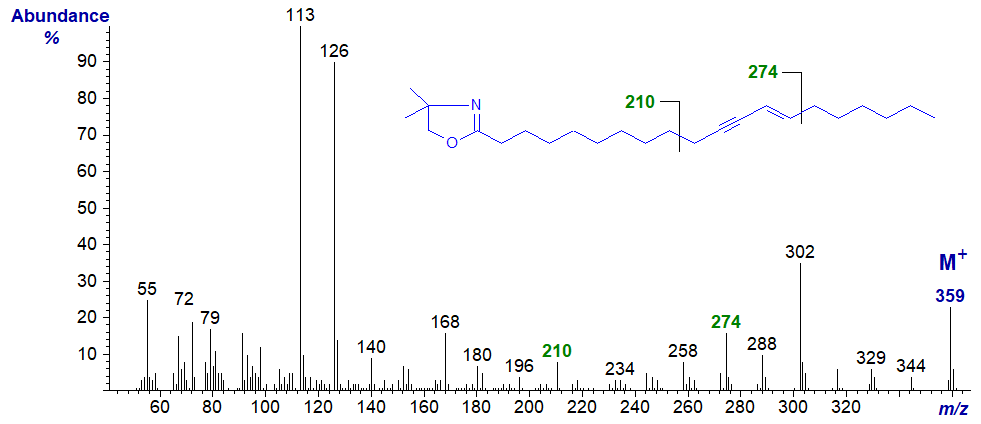Mass Spectrometry of Dimethyloxazoline and Pyrrolidine Derivatives
Acetylenic Fatty Acids
As with other documents in this section, this is a subjective account of mass spectrometry with electron-impact ionization of acetylenic fatty acids, detailing only those encountered during our research activities here and for which we have spectra available for illustration purposes, although I trust that we have a wider range of spectra than are likely to be encountered elsewhere. Many have never been published formally, but I cite references to prior publications when these are known to us. Spectra of DMOX derivatives with pyrrolidides are described in this document, and those for methyl esters and for 3-pyridylcarbinol ('picolinyl') esters are described in separate web pages. Spectra of highly unsaturated acetylenic fatty acids are rarely easy to interpret, and a common failing is to attempt to see more in a spectrum than may be justified. Therefore, it is often useful to simply treat a mass spectrum as a 'fingerprint' for comparison purposes. Another potential problem is that such fatty acids can isomerize or oxidize readily on derivatization or if handled carelessly. The chemistry and occurrence of natural acetylenic fatty acids is discussed in the Lipid Essentials section of this website.
Despite having very different structures, dimethyloxazoline and pyrrolidide derivatives of a given fatty acid have identical molecular weights and fragment in the broadly same way in the mass spectrometer. For this reason, it is convenient to discuss both together here. DMOX derivatives tend to give more abundant diagnostic ions and have better gas chromatography properties, but pyrrolidides give more informative spectra when the functional group is close to either end of the molecule.
Monoynoic Fatty Acids
Octadec-9-ynoic or stearolic acid is a minor component of certain seed oils, although it has long been known as a synthetic product. The mass spectrum of the DMOX derivative of stearolate is -

The spectrum is superficially similar to that of the DMOX derivative of oleate, and a rule like that devised for DMOX derivatives of monoenes should be applied to locate the triple bond. This was first promulgated for the less popular pyrrolidides in a paper by Valicenti et al. (1979) for Δ5 to Δ16 C18 isomers, before that for DMOX derivatives by Zhang et al. (1989), i.e.,
"If a mass separation of 10 instead of the regular 14 amu is observed between two neighbouring even-mass homologous fragments containing n-1 and n carbon atoms of the original acid moiety, a triple bond exists between carbons n and n+1 in the chain".
In the spectrum above, the gap of 10 amu between m/z = 196 and 206 is not very convincing, but the gap of 38 amu between m/z = 182 and 220 is clear and characteristic, and it is arguably a more useful diagnostic aid.
The DMOX derivative of octadec-6-ynoate (tariric acid) from a seed oil of the genus Picramnia has a highly distinctive spectrum -

The ion at m/z = 192 probably corresponds to formation of a stable allenic ion like that at m/z = 154 in the spectrum of the methyl ester derivative, but we can only speculate on how the ion at m/z = 178 is formed. We have no explanation as to why this spectrum is so unusual and so different from the 9-isomer.
The same ions as in the DMOX derivative of stearolate are present in the spectrum of the analogous pyrrolidide, but with much lower intensity relative to the base ion (Valicenti et al., 1979). To my eye, the ions corresponding to the above rule are not at all clear, but each isomer does have a unique fingerprint spectrum. The spectrum of the pyrrolidide of octadec-9-ynoate -

Diynoic Fatty Acids
We had access some years ago to a comprehensive series of bis-methylene-interrupted diynoic fatty acids, prepared by M.S.F. Lie Ken Jie and colleagues and details of the mass spectra of the 3-pyridylcarbinol ester derivatives (only) were published (Christie et al., 1988). For most scientists, these are likely to be of limited academic interest, so one representative spectrum only is illustrated below. Spectra of polyacetylenic fatty acids are rarely easy to interpret, as triple bonds rearrange in complex ways under electron bombardment.
The DMOX derivative of 9,11-octadecadiynoate -

Unusually, the base ion in this spectrum is at m/z = 126, not at 113 as is normal. The spectra of two other positional isomers are very similar, so no further interpretation is given here.
Methylene-Interrupted Ene-ynoic Fatty Acids
Crepenynic or octadec-9-en-12-ynoic acid is a major constituent of some seed oils and is important as a biosynthetic precursor of a family of secondary acetylenic metabolites. The DMOX derivative of crepenynic acid was not easy to prepare, as we found that a cyclization reaction occurred at the high temperature normally employed in the standard procedure, to give amongst other products one component with an internal 6‑membered ring and a conjugated double bond system. The spectrum of this by-product is illustrated in our web page on mass spectrometry of cyclic fatty acids, but the true derivative can be prepared by the relatively mild two-step procedure described in our web pages on Preparation of derivatives) (Christie, 1998). Thus, the mass spectrum of the DMOX derivative of crepenynic acid is -

Interpretation of the authentic spectrum is straightforward, as the double bond is recognized by the gap of 12 amu between m/z = 196 and 208, while the triple bond is characterized by the gap of 10 amu between m/z = 236 and 246. The ions at m/z = 274 and 288 are useful signposts.
The pyrrolidide of crepenynate was prepared by our standard method without difficulty and has a mass spectrum with the same key ions as in that of the DMOX derivative, though much lower in abundance in the higher mass range relative to the base ion.

The most complex fatty acid of this type that we have encountered is octadec-6-yn,9,12,15-trienoate from the moss Dicranum scoparium (courtesy of my former colleague Gary Dobson), and its DMOX derivative has a relatively informative spectrum (Guschina et al., 2002) -

The double bonds in positions 9, 12 and 15 are located by the gaps of 12 amu as marked on the spectrum, but the exact position of the triple bond is impossible to ascertain directly. However, it was confirmed by mass spectrometry after deuteration.
Conjugated Ene-ynoic Fatty Acids
Octadeca-9-yn,11-trans-enoic (ximenynic or santalbic) acid is a component of certain seed oils and many of the spectra that follow were obtained from that of Ximenia americana. The mass spectrum of the DMOX derivative of ximenynic acid has been published elsewhere (Liu et al., 1996) and is -

Faced with a compound of unknown structure, I am doubtful if the spectrum could be interpreted other than that the unsaturation (loss of six H) must be between carbons 8 and 12 (m/z = 182 to 246), but at least it is a useful fingerprint when a standard spectrum is required for comparison. The spectrum of the DMOX derivative of the C20 homologue, eicos-11-yn,13-trans-enoate has comparable features, but shifted 28 amu upwards (and see the spectra of other related homologues in the Archive page) -

As might be expected, the mass spectrum of the pyrrolidide derivative of ximenynate resembles that of the DMOX derivative in that essentially the same ions are seen if in somewhat lower abundance.

The ion at m/z = 70, presumably representing the pyrrolidine ring, appears to be relatively prominent in spectra of pyrrolidides of acetylenic esters, and in that of the pyrrolidide of docosa-13-yn,trans-15-enoate (author, unpublished), it has become the base ion.

The mass spectrum of the DMOX derivative of octadeca-8,10-dien-12-ynoate from the seed oil of Tanacetum corymbosum is even more complicated -

It was only possible to identify the location of the double and triple bonds by isolating the fatty acid as the methyl ester and performing deuteration prior to mass spectrometry of the 3-pyridylcarbinol ester (Tsevegsuren et al., 1988). The methodology is described in our web page on Derivatization of double bonds, with this selected as an example for illustrative purposes.
With octadeca-9-yn,11-trans,13-cis/trans-dienoic acid from a seed oil of the genus Ximenia (author, unpublished), the DMOX derivative has the spectrum -

All we can say with certainty is that the unsaturated centre is between carbons 8 and 14 from the ions at m/z = 182 to 272 as illustrated. In fact, we have not proved this structure definitively, but believe that it is the most probable one on biosynthetic grounds. The mass spectrum of the methyl ester is supportive of this. To my knowledge, this fatty acid has not been reported elsewhere.
Further mass spectra of acetylenic fatty acids in the form of the various derivatives are available, but without interpretation, in the Archive of pyrrolidides and of DMOX derivatives of these web pages.
References
 Christie, W.W.
Mass spectrometry of fatty acids with methylene-interrupted ene-yne systems. Chem. Phys. Lipids,
94, 35-41 (1998); DOI.
Christie, W.W.
Mass spectrometry of fatty acids with methylene-interrupted ene-yne systems. Chem. Phys. Lipids,
94, 35-41 (1998); DOI.- Christie, W.W., Brechany, E.Y. and Lie Ken Jie, M.S.F. Mass spectra of the picolinyl ester derivatives of some isomeric dimethylene-interrupted octadecadiynoic acids. Chem. Phys. Lipids, 46, 225-229 (1988); DOI.
- Guschina, I.A., Dobson, G. and Harwood, J.L. Lipid metabolism in the moss Dicranum scoparium: effect of light conditions and heavy metals on the accumulation of acetylenic triacylglycerols. Physiologia Plantarum, 116, 441-450 (2002); DOI.
- Liu, Y.D., Longmore, R.B. and Fox, J.E.D. Separation and identification of ximenynic acid isomers in the seed oil of Santalum spicatum RBr as their 4,4-dimethyloxazoline derivatives. J. Am. Oil Chem. Soc., 73, 1729-1731 (1996); DOI.
- Spitzer, V. Structure analysis of fatty acids by gas chromatography - low resolution electron impact mass spectrometry of their 4,4-dimethyloxazoline derivatives - a review. Prog. Lipid Res., 35, 387-408 (1997); DOI.
- Tsevegsuren, N., Christie, W.W. and Lösel, D. Tanacetum (Chrysanthemum) corymbosum seed oil: a rich source of a novel conjugated acetylenic acid. Lipids, 33, 723-727 (1998); DOI.
- Valicenti, A.J., Heimermann, W.H. and Holman, R.T. Mass spectrometric location of triple bonds in fatty acids and fragmentation mechanisms of N-acylpyrrolidines. J. Org. Chem., 44, 1068-1073 (1979); DOI.
- Zhang, J.Y., Yu, X.J., Wang, H.Y., Liu, B.N., Yu, Q.T. and Huang, Z.H. Location of triple bonds in the fatty acids from the kernel oil of Pyrularia edulis by gas chromatography-mass spectrometry of their 4,4-dimethyloxazoline derivatives. J. Am. Oil Chem. Soc., 66, 256-259 (1989); DOI.
I can recommend - Christie, W.W. and Han, X. Lipid Analysis - Isolation, Separation, Identification and Lipidomic Analysis (4th edition), 446 pages (Oily Press, Woodhead Publishing and now Elsevier) (2010) - at Science Direct.
| © Author: William W. Christie |  |
|
| Updated: May 2025 | Contact/credits/disclaimer | |
© The LipidWeb is open access and fair use is encouraged but not text and data mining, AI training, and similar technologies.
